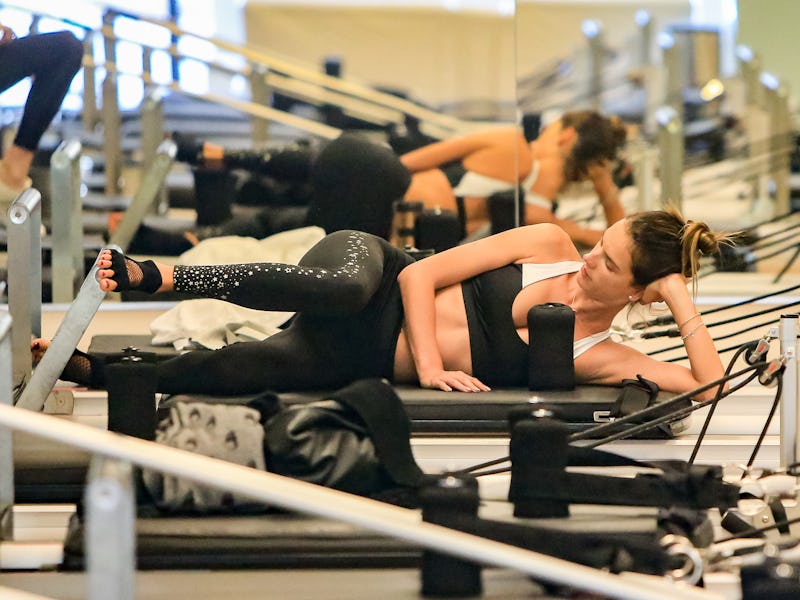Can Exercise Really Induce An Orgasm? Here’s the Truth about “Coregasms”
Lookin’ at you, single-leg plank.

Back in April, the Los Angeles Philharmonic was performing Tchaikovsky’s 5th Symphony when, reportedly, an audience member chimed in with her own emphatic accompaniment. The Internet gawked at this outburst that seemed to be, by all accounts, a full-body orgasm.
Listen, if hearing music could induce orgasm in everyone, perhaps the world would be a better place. But it also begs the question: Are there certain everyday activities that can bring on this release?
There’s evidence that non-sexual physical exercise can provoke what has become known as “coregasms.” Between increased blood flow and muscle exhaustion, specific exercises can induce orgasm.
The physiology of pleasure
For most sexual contexts, the first step toward orgasm is arousal.
Physical and psychological cues have our attention as we’re attuned to impending sexy times during which muscles tense, heart rate and breathing quicken, blood flow increases, and things start to get a little damp in general.
Brain signals related to pleasure zip along many different nerves to the brain, such as the pudendal nerve connected to the anus and genitals, the vagus nerve linked to the gastrointestinal tract and parasympathetic nervous system, and the genital branch of the genitofemoral nerve in the muscles that connect our upper and lower skeleton, called the psoas.
The body channels blood flow toward the genitals, causing the penis, clitoris, scrotum, and labia to swell and become intensely sensitive. Meanwhile, the brain’s hypothalamus releases the pleasure hormone oxytocin.
Arousal can last from minutes to hours, and orgasm is the culmination of these sensations. Involuntary muscle spasms flare, and the pubococcygeus (PC) muscles contract, finally releasing all that pent-up muscular tension. Release of oxytocin peaks, which relaxes all the muscles in the body. There may be waterworks.
“It’s a giant muscle contraction,” says obstetrician and gynecologist Karen Toubi.
Exercise-induced orgasm
Exercise is also a series of rhythmic muscle contractions with increased blood flow, though without arousal cues. Hardworking muscles receive increased blood flow and build tension. They may become so fatigued that they spasm involuntarily. Orgasms may occur if the lower abdominal muscles, psoas, and pelvic floor muscles fatigue and spasm, Toubi says. There’s no single muscle that mediates an orgasm, but rather a group of muscles around the genitals.
A crucial difference is that sexual arousal isn’t necessary for an exercise-induced orgasm. In fact, these sensations can be entirely unexpected and unwanted. “Some people don't even want an orgasm when they're exercising,” Toubi tells Inverse. “They're at the gym and there are people around, it's not always super comfortable.” An exercise-induced orgasm isn’t sexually stimulated at all, nor does it signal sexual desire.
In 2012, sexual health behaviorists Deborah Herbenick and J. Dennis Fortenberry published a study titled “Exercise-induced orgasm and pleasure among women.” This study looked at the results of an online survey of 530 women reporting their experiences with exercise-induced orgasm and exercise-induced sexual pleasure. Sexual thoughts and fantasies were only rarely reported among those who experienced orgasm.
This paper also emphasizes that these orgasms extend beyond the scope of sex: “Findings challenge the idea that women's orgasm is an intrinsically sexual experience.”
Toubi estimates that only about 10 percent of people have this dubious gift and that it’s more common among those with vaginas than those with penises. She’s also heard accounts that it doesn’t feel quite as intense as a sexual orgasm. “People say that it feels like it doesn't last as long, and it doesn't totally take over them.”
Exercises for a good time
For those seeking an exercise-induced orgasm, core workouts seem to be a good place to start. Other exercises that can fatigue those pelvic muscles include single leg plank, hanging side crunches, hanging straight leg raises, and lifting medicine balls. The 2012 paper also notes that the most common exercises reported to induce orgasm were ab exercises, climbing, and lifting weights.
The thing is, this is a two-way street. While exercising may bring on climax for some outside of a sexual context, abdominal and core strengthening can actually enhance climax in the bedroom — for everyone.
“If you have stronger muscles, if you exercise more, you'll have stronger orgasms,” she says. “Together with making your pelvic floor stronger and having a stronger core, all of that really contributes to having a more intense and a more satisfying sexual life.”
This article was originally published on